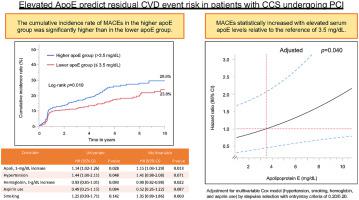Atherosclerosis ( IF 4.9 ) Pub Date : 2021-08-12 , DOI: 10.1016/j.atherosclerosis.2021.08.021 Tatsuya Fukase 1 , Tomotaka Dohi 1 , Yuichi Chikata 1 , Norihito Takahashi 1 , Hirohisa Endo 1 , Shinichiro Doi 1 , Hiroki Nishiyama 1 , Yoshiteru Kato 1 , Iwao Okai 1 , Hiroshi Iwata 1 , Shinya Okazaki 1 , Kikuo Isoda 1 , Katsumi Miyauchi 1 , Hiroyuki Daida 1 , Tohru Minamino 2

|
Background and aims
Little is known about the long-term impact of apolipoprotein E (apoE) on residual cardiovascular risk in patients with chronic coronary syndrome (CCS) receiving statin treatment.
Methods
A total of 1109 consecutive patients (mean age, 67 ± 10 years; 83% men) with CCS who underwent their first intervention between 2000 and 2016 were included in this study. All patients had achieved low-density lipoprotein cholesterol (LDL-C) <100 mg/dL on statin treatment and were divided into two groups based on median serum apoE values. We evaluated the incidence of major adverse cardiovascular events (MACEs), including cardiovascular death, non-fatal acute coronary syndrome, and target vessel revascularization.
Results
A total of 552 and 557 patients were categorized to the higher and lower apoE groups, respectively. There were significant relationships between apoE levels and total cholesterol levels, triglyceride levels, high-density lipoprotein cholesterol levels, and estimated remnant cholesterol, except for LDL-C levels. During the median follow-up period of 5.1 years, 195 patients (17.6%) developed MACEs. Kaplan-Meier analysis revealed that the cumulative incidence of MACEs in the higher apoE group was significantly higher than in the lower apoE group (29.5% vs.23.8% log-rank test, p = 0.019). Using multivariable Cox hazard analysis, serum apoE level (1-mg/dL increase) (hazard ratio 1.15; 95% confidence interval 1.03–1.29, p = 0.013) was the strongest independent predictor of MACEs.
Conclusions
Serum apoE level could be a strong predictor of residual cardiovascular risk in patients with CCS long-term, even if LDL-C levels are controlled with statin treatment.
中文翻译:

血清载脂蛋白 E 水平预测接受首次经皮冠状动脉介入治疗和他汀类药物治疗的慢性冠状动脉综合征患者的残余心血管风险
背景和目标
对于接受他汀类药物治疗的慢性冠状动脉综合征 (CCS) 患者,载脂蛋白 E (apoE) 对残余心血管风险的长期影响知之甚少。
方法
本研究共纳入 1109 名在 2000 年至 2016 年期间接受首次干预的 CCS 患者(平均年龄,67 ± 10 岁;83% 为男性)。所有患者在接受他汀类药物治疗时均达到低密度脂蛋白胆固醇 (LDL-C) <100 mg/dL,并根据血清 apoE 值中位数分为两组。我们评估了主要不良心血管事件 (MACE) 的发生率,包括心血管死亡、非致命性急性冠状动脉综合征和靶血管血运重建。
结果
总共 552 和 557 名患者分别被归类到较高和较低的 apoE 组。除了 LDL-C 水平外,apoE 水平与总胆固醇水平、甘油三酯水平、高密度脂蛋白胆固醇水平和估计的残余胆固醇之间存在显着关系。在 5.1 年的中位随访期间,195 名患者 (17.6%) 发生了 MACE。Kaplan-Meier 分析显示,高 apoE 组的 MACE 累积发生率显着高于低 apoE 组(29.5%对23.8% 对数秩检验,p = 0.019)。使用多变量 Cox 风险分析,血清 apoE 水平(增加 1-mg/dL)(风险比 1.15;95% 置信区间 1.03–1.29,p = 0.013) 是 MACE 最强的独立预测因子。
结论
即使通过他汀类药物治疗控制了 LDL-C 水平,血清 apoE 水平也可能是 CCS 患者长期残余心血管风险的强预测因子。











































 京公网安备 11010802027423号
京公网安备 11010802027423号